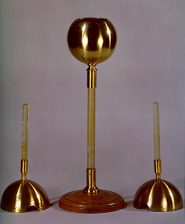
42.2 x 15.1 (hollow sphere)
32 x 11.9 and 23.6 x 11.9 (caps)
Brass, glass and wood
CAT. 1878 : 346
Esphera ouca de Coulomb com duas calotes.
Hollow Coulomb sphere with two caps.
This apparatus was used to demonstrate that the charge in a conducting body is distributed on its surface. It consists of a hollow brass sphere and two spherical caps, also brass. The sphere has a round opening in its upper part and is fixed to a glass insulator rod, standing on a wooden base. The caps are also equipped with a glass insulator rod, which serves as a handle. They can completely cover the sphere.
When the sphere is electrically charged and covered by the caps in such a way that the three pieces are touching, its discharge is observed as a result of a flux of electrical charge to the caps. This experiment shows that the charge is distributed on the exterior surface of the metal body.
Another interesting experiment was studying the influence of an electrically charged body placed inside the electrically discharged sphere, without touching it. If the charged body was introduced into the sphere and withdrawn, an electrometer would show that the sphere remained discharged. But if the sphere was enclosed by the caps, initially discharged, with the charged body placed inside it in such a way that there was no contact between the influencer and the interior of the sphere, a symmetrical distribution of charge was observed on the hollow sphere and the caps. For this, they should be removed before taking the charged body out. With an electrometer it could be seen that the electric charge on the sphere is opposite to that of the influencer.
This instrument was acquired by the Gabinete de Física in 1864.
Daguin, Pierre-Adolphe, Traité Élémentaire de Physique Théorique et Expérimentale, 3rd edition, Paris, 1867, Vol. IV, n.º 1296.